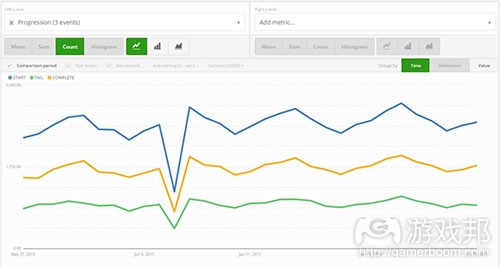所有游戏开发者都应该知道的一些参数
作者:GameAnalytics
我们会觉得手机游戏分析很复杂。当提到参数时。我们需要追踪许许多多的数字。从较为简单的层面看来,存在像下载量,游戏session和DAU等参数。这些数字多是相对直接的,且能够衡量一些具体行动。而像用户流失率,每付费用户平均收益(ARPPU)和DAU/MAU等较复杂参数就不是那么好理解,并且它们也会引出更多问题。如:
“在我考虑一个流失用户前我是否应该先等等看?”
“有效的ARPPU是怎样的?”
我们甚至还未提到像市场细分,漏斗和自定义事件等更高级的分析概念。现在我们将只是专注于参数并着眼于这些数字能够告诉你有关游戏的神秘内容。尽管关于游戏分析并不存在完全对策,但是还是存在一些能够帮助你更好地完善自己的手机游戏的有效参数。
每日活跃用户(DAU)
让我们从最基础的开始。DAU是指在任何一天开始玩你的至少一个游戏回合的用户数。从本身看来,DAU和其它高级别参数并不能提供给你有关应用表现的相关内容。然而了解这些简单的参数对于任何分析讨论来说都是一个很好的起点。
让我们举个例子来说。例如一款拥有1万名忠实用户的硬核游戏。这些用户每天都会玩几次游戏并且都会积极地在游戏中获取赢利。让我们将其与那些拥有100万DAU但却没有赢利机制的通讯类应用相比较。还有一种应用是运行着用户获取活动但却具有糟糕用户留存的应用。今天它们可能拥有50万的DAU,但是明天可能会降到10万。DAU指数只是一种瞬时的数据,其周围的环境同样也很重要。
session
每次当任何用户(不只是特别的用户)打开你的应用,这便算是一个session。与DAU相似的是,总的session数需要一些环境的支持才能构成一个有帮助的数值。例如每DAU的平均session能够告诉你游戏的用户粘性。
一款应用的类型将会影响它的session/DAU,就像一些游戏风格拥有更频繁的session。然而如果用户每天会回到游戏中5至10次,那么你便可以大胆地说他们喜欢你的游戏。而如果用户每天只会打开游戏1,2次,那么游戏便很难长久地留住他们的注意力。
DAU/MAU
日活跃用户与月活跃用户间的比例能够告诉你一款应用的用户留存与用户粘性。这一参数能够告诉你用户登录应用的频率。我们可以使用一些例子而更好地讨论这一参数。
让我们假设一款应用拥有10万MAU以及平均1.5万DAU。所以DAU/MAU比例便是15%。这意味着这个月平均用户每天登录率为15%。
因为这是一个比例,所以DAU/MAU参数只能是0至1之间的数值。如果数值越接近1,这便意味着用户每天打开应用的次数越多。像Facebook等著名的社交网络应用便拥有高达50%的DAU/MAU比例。但大多数成功游戏的DAU/MAU比例只有20%左右。
用户留存
用户留存是免费游戏中最重要的参数。成功的免费游戏总是能够与用户维持长久的关系。喜欢拥有更多体验的用户总是愿意为具有竞争性的优势买单。一款想要拥有强大用户留存的游戏需要花更多时间去创造这样的关系。
为了计算用户留存值,你应该从用户下载你的应用那天开始将其划分成不同群组。他们下载应用的那一天算为第0天。如果用户隔天打开你的应用(第1天),你便可以将其标记为留存。如果他们并未打开应用,他们便是未留存。这种计算方法适合用于计算用户下载完应用后每一天的用户流失情况。而较常出现的用户留存天数是1天,3天,7天和30天。
转换率
让我们转向所有人都很喜欢的一个主题:钱!上述参数都是专注于衡量你与用户之间的关系。他们回到你的应用的频率是怎样的?而对于许多独立开发者而言最重要的参数还是他们的游戏能否赚钱。
转换率能够衡量在所有用户中特定时期内购买了游戏内容的特殊用户的比例。你也可以借此衡量免费游戏中的广告转换率。
让用户在本来能够免费体验的游戏中付钱是一件很困难的事。但与许多其它产业一样,重复购买者也能在免费游戏中创造大量的收益。你可以通过提供给用户具有惊人价值的虚拟道具而促成他们的首次转换。
ARPDAU
每付费用户平均收益(ARPPU)能够衡量那些已经在游戏中完成一次购买的用户子集。基于不同游戏类型,这一参数也会有所不同。就像硬核游戏更倾向于拥有更高的ARPPU等参数,但是它们却缺少像休闲游戏所拥有的大众吸引力。
用户流失
用户流失大致上与用户留存相反。有多少下载了你的游戏但却未继续游戏的玩家?在订阅式业务模式中流失参数是很重要的,而当将它与免费游戏联系在一起时便会出现一些细微的差别。
这里的主要考虑因素是用户的游戏风格。基于订阅服务,用户流失非恶即善。不管用户是否是付费用户。在一款免费游戏中,有些用户一天可能会玩多次游戏,而一些更休闲的玩家可能一或两周才会登录游戏一次。为了面对这些玩家间的差异,我们将用户流失限定在那些28天内未完游戏的玩家们。
游戏内部的参数
除了理解用户粘性,用户留存以及盈利外,我们还必须衡量并平衡游戏经济。如果赚取虚拟货币太过简单的话,用户也就没有获得盈利的理由了。但是用户仍然需要拥有足够的货币去享受并探索游戏。以下是一些能够帮助玩家找到货币的参数。
资源,槽和流
资源是用户能够赚取虚拟货币的地方。在GameAnalytics的控制面板上,资源参数能够衡量用户已经挣得的货币数。这同时也包含作为设计师的你提供给他们的任何货币。
槽与资源相反。在你的游戏中存在一个用户能够消费他们珍贵的货币的地方。而不管是资源还是槽都是关于升水(硬)货币和第二(软)货币。在分析过程中你应该有效区分这些不同类型的货币。
结合资源和槽你便能够获得流。流是指你的玩家所消耗和挣得的货币的总平衡。通常情况下流应该保持稳定,就像如下图表那样。
如果图表像指数曲线那样倾斜向上,这便表示你的玩家基础拥有太多货币并不需要盈利。而如果图表向零倾斜,那就表示你的玩家在游戏中缺少足够的资源。
开始,失败和完成
最后,我们将着眼于一些进程参数。不管用户是否开始一个全新的关卡,许多游戏类型都拥有一个关卡组件。开始能够衡量玩家开始一个全新关卡的次数。
其次是失败。失败总是会在玩家开始一个关卡但却未完成该关卡的时候出现。
而就像你所猜想的那样,完成能够计算用户完成一个特点关卡的次数。尝试所有的这三种参数能够帮助你更好地分析游戏关卡。
你所设置的阻碍是否基于适当的难度?用户是否会出乎意外地被困在一些特定的关卡中?哪个关卡是用户觉得最有趣并最常重复的?开始,失败和完成参数便能够帮助你回答这些问题。
尽管关于游戏分析并不存在任何魔法配方,但是上述参数却能够帮助你在分析世界中迈开脚步。手机游戏分析中最重要的一部分便是开始并为你的游戏确定一个基准。一旦你理解用户的表现,你便能够衡量像游戏更新或者用户获取策略的改变所具有的影响。
(本文为游戏邦/gamerboom.com编译,拒绝任何不保留版权的转发,如需转载请联系:游戏邦)
15 Metrics All Game Developers Should Know by Heart
By GameAnalytics
Mobile game analytics can feel complicated. When it comes to metrics, there are hundreds of numbers to track. On the simpler end of the spectrum, there are metrics like downloads, sessions, and DAUs. These numbers are relatively straightforward and measure concrete actions. More complicated metrics includes things like churn, Average Revenue Per Paying User (ARPPU) and DAU/MAU. These are less intuitive to interpret, and they might raise more questions than answers.
“Am I waiting the right amount of time until I consider a user churned?”
“What is a good ARPPU?”
And we haven’t even introduced more advanced analytics concepts like segmentation, funnels and custom events! For now, we’ll stick to just the metrics and look at what these numbers actually tell you about your game. While there’s no one-size-fits-all policy for game analytics, there are some useful metrics that can help shed light on how you can improve your mobile game.
Daily Active Users (DAUs)
Starting with the basics, DAU is the number of unique users that start at least one session in your app on any given day. By themselves, DAU and other high level metrics don’t provide much insight into an app’s performance. However, knowing these simple metrics is a useful starting point for an educated analytics discussion.
Let’s look at an example. Take a hardcore game that has 10,000 engaged users. These users all play the game several times each day and actively monetize. Compare that to a news or messaging app that has 1,000,000 DAUs but no monetization mechanics. A third app that has poor retention might run a user acquisition campaign. Today they have 500,000 DAUs, but tomorrow they are down to 100,000. A DAU count is merely a snapshot in time, and the surrounding context can be just as important, if not more important, than a large user base.
Sessions
Every time any user, not just a unique user, opens your app, that counts as a session. Similar to DAUs, the total number of sessions requires some context to be a helpful number. Specifically, focus on the average number of sessions per DAU, as this metric can tell you about how engaged users are with your game.
An app’s genre does have an effect on Sessions/DAU, as some game styles lend themselves to more frequent sessions. However, if users are coming back five to ten times each day, it’s safe to assume they enjoy the game. If users only open an app one to two times per day, it is unlikely to keep their attention for long.
DAU/MAU
The ratio of Daily Active Users to Monthly Active Users shows how well an app retains users and is often referred to as the stickiness of a game. This metric shows you how frequently users log in to your app. This metric will be easier to discuss with an example.
Let’s say an app has 100,000 MAU and averages 15,000 DAU. Then, the DAU/MAU ratio would be 15 percent. This means that the average user logged in on roughly 15 percent of the days that month.
Since this is a ratio, the metric DAU/MAU can only be a value between zero and one. Values closer to one, mean users are opening the app on a higher percentage of days. Popular social networking apps like Facebook have reported DAU/MAU ratios as high as 50 percent. But most successful gaming apps have ratios closer to 20 percent.
Retention
Retention is arguably the most important metric in a free-to-play game. Successful free-to-play games create long-term relationships with users. Users that enjoy the experience enough are willing to pay to for a competitive advantage. A game needs to have strong retention to have time to build this relationship.
To calculate retention, separate your users into cohorts based on the day they download your app. The day that the download occurs is Day 0. If a user opens your app the next day (Day 1), they are marked as retained. If they do not open the app, they are not retained. This calculation is performed for user cohort on each day after they download the app. Common days used for retention are 1, 3, 7 and 30.
Conversion Rate
Moving right along to everyone’s favorite topic: money! The above metrics focus on measuring your relationship with your users. How often do they come back to your app? But the most important metric for many indie developers is whether their game is making enough money.
The conversion rate measures the percentage of unique users that have made a purchase out of the total number of users during that time period. You can also measure the conversion rate of ads served in a free-to-play game.
Getting a user to pay real money in a game that they can play for free is a difficult assignment. But, as with many other industries, repeat purchasers generate the majority of revenue in free-to-play games. Encourage users to make that first conversion by offering them a virtual item of incredible value.
ARPDAU
The Average Revenue Per Daily Active User, or ARPDAU, is one of the most commonly discussed metrics in mobile games. ARPDAU is a useful metric because it allows you to understand how your game performs on a daily basis.
This is a great metric to track before and during user acquisition campaigns. Before acquiring users, make sure you know the range of your ARPDAU and how it fluctuates normally. During a campaign, segment your new users by source and see which networks or games perform the best in your app. We’ll discuss segmentation in a later post.
ARPPU
Average Revenue Per Paying User (ARPPU) measures only the subset of users who have completed a purchase in a game. This metric can vary dramatically based on game genre. Hardcore games tend to have higher monetization metrics like ARPPU, but they also lack the mass appeal of more casual games.
Churn
Churn is roughly the opposite of retention. How many players that downloaded your game are no longer playing? The churn metric makes the most sense in a subscription business model and there are some nuances involved when applying it to free-to-play games.
The main consideration is user play style. With a subscription service, churn is black and white. Either a user is paying or they are not. In a free-to-play game some users may play multiple times per day, while more casual players log in once or twice a week. To generalize for these differences between users, we measure churn as a user who has not played in 28 days.
In-Game Metrics
Beyond understanding user engagement, retention and monetization, it is important to measure and balance the game economy. If it is too easy to earn virtual currency, users have no reason to monetize. But users still need enough currency to enjoy and explore the game. There is a happy medium somewhere in between, and the following metrics can help find it.
Source, Sink and Flow
Sources are places where users can earn virtual currency. In the GameAnalytics dashboard, the source metric measures the amount of currency a user has earned. It also includes any currency he or she has generously been given by you, the benevolent game designer.
A sink is the opposite of a source. These are the locations in your game where users spend their precious currency. Both sources and sinks can refer to premium (hard) and secondary (soft) currencies. Keep these different types of currencies separate during your analysis.
Combining sources and sinks gives you the flow. Flow is the total balance of currency that your players have spent and earned. Generally the flow should look stable like in the chart below.
If the chart skews upward like an exponential curve, your player base will have too much currency and no need to monetize. If the chart slopes negatively to zero, players won’t have enough resources to do anything in your game.
Start, Fail and Complete
Lastly, we will look at some progression metrics. Whether or not the user has to explicitly start a new level, many game types have a leveling component. Starts measure the number of times a player starts a new level.
Second in the creatively named metrics category are fails. A fail occurs when a user starts a level but does not complete it.
As you might expect, a complete counts the number of times users complete a certain level. Tying all three of these together helps you analyze the levels in your game.
Are your choke points appropriately difficult? Are users getting stuck on certain levels unexpectedly? Which levels are users having the most fun playing and repeating? Starts, fails and completes can answer these types of questions.
While there is no magic recipe for game analytics, the above metrics are standards that can help you get started in the world of analytics. The most important part of mobile game analytics is to get started and establish benchmarks for your own games. Once you understand how your users behave, you can measure things like the impact of a game update or changes to your user acquisition strategy.(source:gamedev)
下一篇:有效进行游戏软发行的三个步骤











































